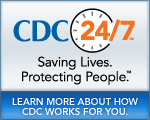MMWR
Morbidity and Mortality Weekly Report
MMWR News Synopsis for March 26, 2009
- Nonfatal Injuries from Falls Associated with Dogs and Cats a€“ United States, 2001-2006
- Application of Lower Sodium Intake Recommendations to Adults a€“ United States, 1999-2006
- Cluster of Ciguatera Fish Poisoning a€“ North Carolina, 2007
There will be no MMWR telebriefing scheduled for March 26, 2009.
1. Nonfatal Fall-Related Injuries Associated with Dogs and Cats
a€“ United States, 1999-2006
PRESS CONTACT: CDC
National Center for Injury Prevention and Control
(770) 488-4902
Dogs and cats provide comfort and companionship, but ita€?s important to realize that pets and pet items can cause falls that result in injuries, including fractures.?? Every day it is estimated that an average of 240 people are treated in emergency departmentsa€”about 86,600 each yeara€”for injuries from falls involving dogs and cats. This study examined five years of emergency department data and found that 88 percent of fall injuries involved dogs than cats.?? Among injuries related to dogs, about 31 percent of persons fell or tripped over dogs and 21 percent fell after being pushed or pulled by dogs.?? For injuries related to cats, 66 percent fell or tripped over cats. Raising public awareness that pets can cause falls and pets and pet-related items can be fall hazards can help reduce possible injuries.?? This study reinforces the American Veterinary Medical Associationa€?s recommendation for obedience training for dogs to reduce behaviors such as pushing and pulling that can cause falls.
Application of Lower Sodium Intake Recommendations to Adults a€“ United States
2001-2006
PRESS CONTACT: CDC
Division of Media Relations
(404) 639-3286
Most Americans consume substantially more salt than is recommended or needed. Reducing high sodium consumption among Americans is a very complex national issue that will take efforts from various sectors a€” public, private and the general public. Reducing sodium content of foods is critical in protecting the health of Americans, which is way CDC along with other HHS agencies will be working with major food manufacturers and chain restaurants to reduce sodium levels in the food supply. If people are aware of the upper limit of their daily recommended sodium intake and nutritional labels reflect that limit, they can take informed steps to reduce the amount of sodium in their diet. ??A new CDC study found that the recommended sodium intake of no more than 1,500 mg/day applies to more than two-thirds of the U.S. adult population.?? This study is the first to use national data to show that at least 69.2 percent of the adult population belong to a specific population group, including persons with high blood pressure, blacks, or middle-aged and older adults, that should aim to consume no more than1,500 mg of sodium per day.?? Dietary sodium intake is important because higher consumption of sodium is strongly associated with increase in the risk of having higher blood pressure, a leading cause for heart disease and strokes a€” the first and third leading causes of death in the U.S.
Cluster of Ciguatera Fish Poisoning a€“ North Carolina, 2007
PRESS CONTACT:
Carol Schriber
Public Affairs, North Carolina Division of Public Health
(919) 733-9190
Ciguatera Foodborne Poisoning may be associated with rare reports of painful sexual intercourse after the consumption of the fish.?? The North Carolina Division of Public Health investigated a nine-person cluster of ciguatera foodborne poisoning in June 2007.?? Our objective in presenting this information is to inform physicians and public health officials that in addition to classic ciguatera fish poisoning symptoms, unusual genital symptoms may occur after consuming contaminated fish. In this outbreak, the consumption of fish contaminated with ciguatoxin was associated with rare reports of painful sexual intercourse.??
####
- Historical Document: March 26, 2009
- Content source: Office of Enterprise Communication
- Notice: Links to non-governmental sites do not necessarily represent the views of the CDC.
View Press Releases in
Get e-mail updates
To receive e-mail updates about this page, enter your
e-mail address:
Contact Us:
- Centers for Disease Control and Prevention
1600 Clifton Rd
Atlanta, GA 30333 - 800-CDC-INFO
(800-232-4636)
TTY: (888) 232-6348 - Contact CDC-INFO


